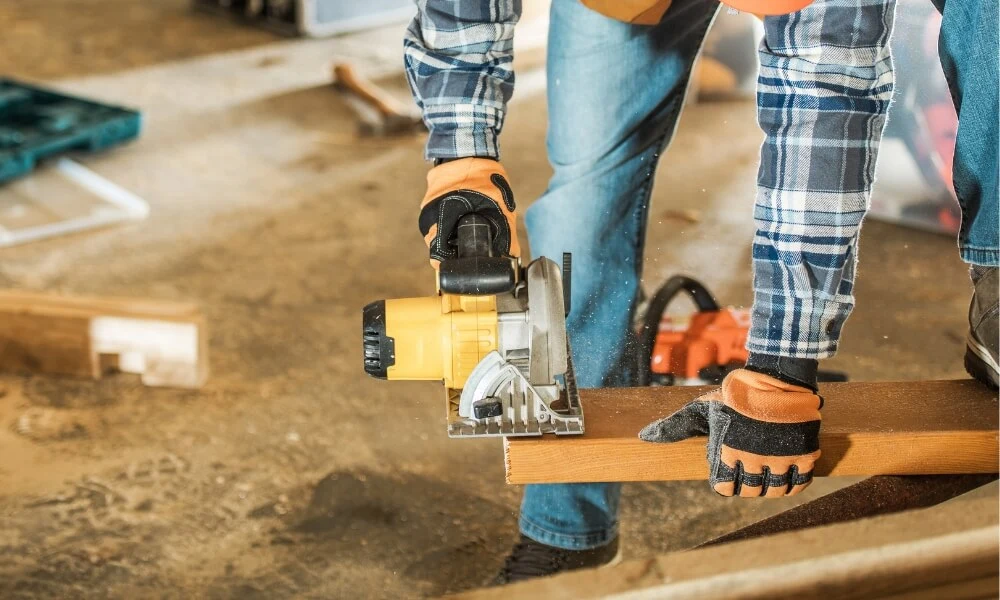Power tools, whether used for a home improvement project, crafting, or professional work, can be incredibly helpful, making tasks easier and more efficient. However, these powerful devices can pose significant safety risks if not properly used. Some dangers are apparent, like sharp blades or fast-moving parts. Yet, unseen hazards can be easily overlooked, potentially leading to accidents and injuries.
This blog post delves into the often unseen hazards of using power tools. We will cover noise, vibration, dust, kickback, electric shocks, fire, eye injuries, repetitive motion hazards, battery-related risks, and lack of machine guarding. Each of these aspects presents unique challenges, but by understanding these risks and implementing the proper safety measures, we can effectively mitigate them.
We aim to increase your awareness of these hazards and provide practical tips on avoiding them, thus promoting a safer environment whether you’re a DIY enthusiast, a hobbyist, or a professional tradesperson. Safety should always be the first priority when using power tools, and it’s our hope this guide will help you use your tools more confidently and safely. So, let’s dig deeper and unpack these hazards one by one.
Power Tools Hazards and How to Avoid Them
Power tools can be incredibly beneficial in various projects, making tasks easier and more efficient. However, they can also pose significant safety risks if not used properly. Some hazards might not be immediately apparent, but understanding them is vital for your safety. Here are some unseen power tool hazards and how to avoid them:
1. Noise Hazards
Noise hazard is a significant yet often overlooked risk associated with power tool usage. Many power tools, including saws, drills, grinders, and air compressors, produce high noise levels. Frequent and prolonged exposure to these high noise levels can lead to irreversible hearing loss, tinnitus (ringing in the ears), and other auditory complications.
This happens due to the effect of loud noise on the inner ear, specifically the cochlea, a spiral-shaped part filled with tiny hair cells. These cells convert sound vibrations into electrical signals that our brains interpret as sound. Prolonged or intense exposure to loud noises can damage or destroy these hair cells, leading to hearing loss.
Several factors come into play in determining the risk of hearing damage:
- Intensity or loudness of the sound: Measured in decibels (dB), the higher the decibel level, the greater the risk of hearing damage. Normal conversation is about 60 dB, a running vacuum cleaner is 75 dB, and a power saw can be over 100 dB. Regular exposure to noise above 85 dB can cause hearing damage.
- Duration of exposure: The longer the exposure to high decibel levels, the greater the risk of hearing damage. The Occupational Safety and Health Administration (OSHA) recommends that noise exposure not exceed 90 dB over an 8-hour workday.
- Distance from the noise source: The closer you are to the source of loud noise, the more likely it is to cause damage.
- Frequency of exposure: Regular and repeated exposure to loud noise increases the risk of hearing damage.
To protect yourself from noise hazards:
- Use Ear Protection: Earplugs and earmuffs can reduce the amount of sound reaching the ears. Earplugs are inserted in the ear canal, reducing noise by 15-30 dB. Earmuffs fit over the entire outer ear and can reduce noise by 15-30 dB. For especially loud environments, using both can provide better protection.
- Use Low-Noise Tools: Choose power tools designed to operate more quietly.
- Maintain Your Tools: Properly maintained tools are less likely to produce excessive noise.
- Take Breaks: Regular breaks away from the noisy environment can help prevent hearing damage.
- Regular Hearing Checks: If you regularly work with power tools, it is advisable to have regular hearing checks. These can help identify hearing loss early, so steps can be taken to prevent further damage.
Remember, when damaged, auditory nerves and hair cells cannot be repaired or replaced. Therefore, it’s essential to protect your hearing when operating power tools.
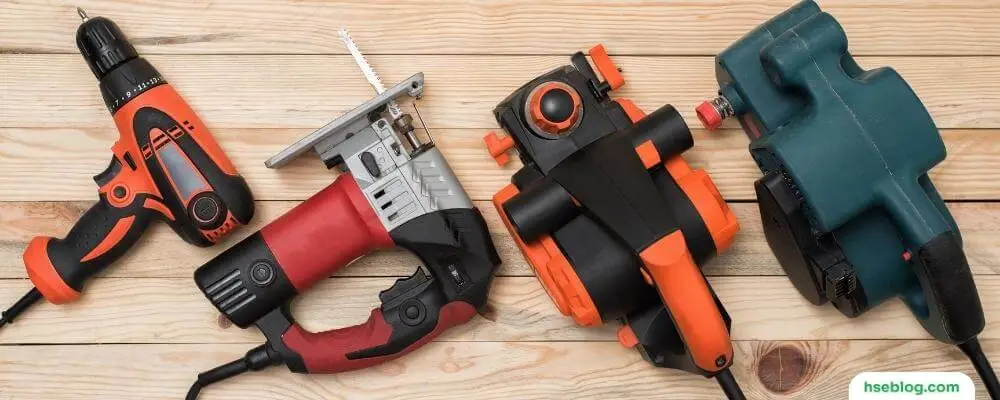
2. Vibration Hazards
Hand-Arm Vibration Syndrome (HAVS) is a potentially serious condition resulting from extended exposure to vibration, especially from handheld power tools. HAVS can be caused by any tool that causes a lot of vibration, such as grinders, jackhammers, and chainsaws, but even lighter tools like drills and sanders can cause it over time.
HAVS is characterized by a range of symptoms, including:
- Vascular symptoms include blanching (whitening) of the fingers, especially in cold conditions, which can be painful (a condition known as vibration white finger or VWF).
- Neurological symptoms: These can range from a reduced sense of touch, tingling, and numbness in the fingers to a loss of hand dexterity and strength.
- Musculoskeletal symptoms may include pain and stiffness in the hands, wrists, and arms and reduced grip strength.
Extended exposure to vibration can cause the symptoms to worsen over time and become chronic, leading to disability and impairing the person’s ability to do fine work or even everyday tasks.
Here are some ways to reduce the risk of HAVS:
- Anti-vibration gloves: These are designed to dampen the vibration energy transmitted to the hands. They can help but can’t eliminate the risk of HAVS on their own.
- Anti-vibration tools: Some tools are designed to produce less vibration, which can significantly reduce the risk of HAVS. Look for tools labeled as ‘low vibration’ or ‘anti-vibration.’
- Regular breaks: Avoid continuous use of vibrating tools for long periods. The UK Health and Safety Executive (HSE) recommends a limit of about 15 minutes of continuous use for many high-vibration tools.
- Tool maintenance: Keep tools in good working order. Damaged or worn tools can vibrate more than they should.
- Training: Be trained in the proper use of tools to reduce unnecessary vibration. For example, avoid using excessive force, which can increase the vibration level.
- Health surveillance: If you regularly use high-vibration tools, you should have regular health checks to catch any symptoms of HAVS early.
Remember, early diagnosis and intervention in cases of HAVS are essential to prevent long-term damage and disability. If symptoms start to appear, seeking medical advice immediately is important.
3. Dust Hazards
The dust generated by power tools can indeed pose significant health and safety hazards. Depending on the material being worked on, the dust can contain various harmful substances, including wood dust, silica dust, and metal dust. Inhaling these substances can lead to several health issues, such as:
- Respiratory problems: Prolonged exposure to dust can lead to conditions such as asthma, chronic obstructive pulmonary disease (COPD), and silicosis (a lung disease caused by breathing in tiny bits of silica, a mineral that is part of sand, rock, and mineral ores such as quartz).
- Cancer: Certain types of dust, such as wood dust and silica dust, are known carcinogens, and prolonged exposure can increase the risk of developing cancers, particularly lung cancer.
- Allergies: Many people are allergic to certain types of dust, and exposure can lead to allergic reactions.
- Eye irritation: Dust can also cause eye irritation and injury.
In addition to these health hazards, dust can create workplace safety hazards. It can make surfaces slippery, leading to slips and falls, and can potentially cause fire or explosion if there’s a source of ignition.
To mitigate dust hazards, consider the following precautions:
- Dust extraction systems: Also known as dust collectors, these systems are designed to remove dust at the source, preventing it from becoming airborne. Many power tools have attachments or built-in systems for dust extraction.
- Personal Protective Equipment (PPE): Always wear a dust mask or a respirator when using power tools to prevent dust inhalation. The type of respirator required will depend on the dust type and concentration. Safety glasses or goggles should also be worn to protect the eyes from dust.
- Clean work area: Regular cleaning can help reduce dust accumulation and the associated slip hazard.
- Ventilation: If you’re working indoors, ensure the workspace is well-ventilated to disperse any dust that becomes airborne.
- Safe disposal: Collect and dispose of dust safely. Some dust, like sawdust, can be composted, but other types of dust may require special disposal procedures due to their hazardous nature.
- Tool choice and maintenance: Using the right tool for the job can help minimize dust generation. Also, keeping your tools well-maintained and sharp can make cuts cleaner and produce less dust.
By implementing these precautions, you can significantly reduce the risk associated with dust hazards when using power tools.
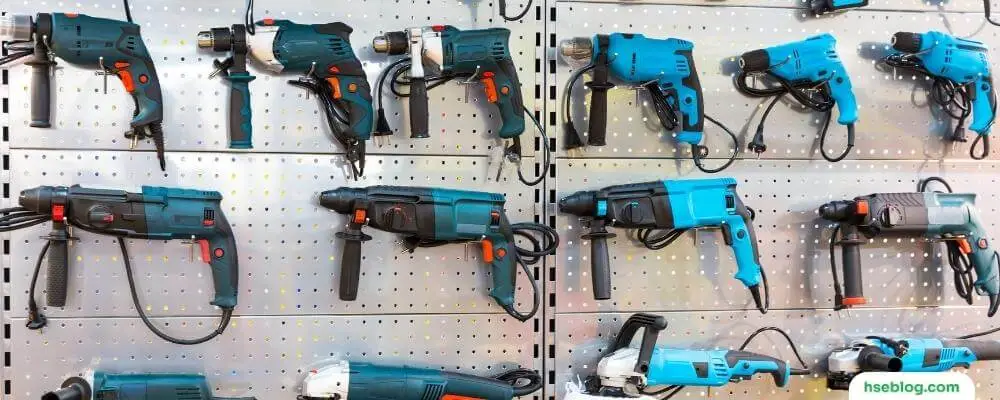
4. Kickback Hazards
Kickback is a dangerous and unexpected reaction that can happen when using power tools, especially cutting tools like table saws, circular saws, and chainsaws. When the tool’s blade binds or catches in the material, it can cause the tool to violently jerk or kick back toward the user. This can result in serious injuries, including cuts, puncture wounds, or even more severe injuries, especially if the tool comes into contact with the face or torso.
Kickback generally occurs due to one or more of the following:
- Cutting with a dull blade: Dull blades don’t cut as efficiently as sharp blades, making them more likely to bind in the material.
- Forcing the tool: Applying too much force to the tool can cause the blade to bind or skew, increasing the risk of kickback.
- Incorrect feed rate: Feeding the material too fast or too slow into the blade can also lead to binding.
- Twisted or warped material: If the material being cut is warped or twisted during the cut, it can pinch the blade and cause kickback.
- Improper setup or usage of the tool: Not setting it up properly or not using it correctly can also increase the risk of kickback.
Here are some safety measures to reduce the risk of kickbacks:
- Use sharp blades: Sharp blades cut more efficiently and are less likely to bind in the material. Regularly check and sharpen your blades as needed.
- Don’t force the tool: Allow the tool to do the work. Applying excessive force can cause the blade to bind or distort.
- Use anti-kickback features: Many power tools have safety features to prevent kickback. For example, table saws often have anti-kickback pawls and riving knives. Make sure to use these features if your tool has them.
- Maintain proper control: Always keep a firm grip on the tool, and ensure your stance allows you to resist kickback force without losing your balance or control of the tool.
- Correct tool setup and usage: Always set up and use your tools according to the manufacturer’s instructions. This can significantly reduce the risk of kickbacks.
- Use push sticks or feather boards: When using table saws or other stationary cutting tools, use push sticks or feather boards to guide the workpiece, keeping your hands away from the blade.
- Proper workpiece preparation: Ensure the cut material is free from knots, nails, or other obstructions. If the material is warped, ensure it remains flat during the cut.
By understanding the causes of kickbacks and following these safety measures, you can significantly reduce the risk of injury when using power tools.
5. Electric Shock Hazards
Electric shock is a serious risk when using power tools, especially those that are powered by mains electricity. An electric shock can occur if the body becomes part of an electrical circuit, allowing current to pass through it. This can cause injuries ranging from minor burns and muscle contractions to severe burns, heart arrhythmia, or even death.
There are several situations where power tools can become electrically live and pose a risk:
- Faulty wiring or insulation: If a tool’s wiring or insulation is damaged, it could lead to a short circuit that makes the tool’s casing live.
- Wet conditions: Water is a good conductor of electricity, so using power tools in wet or damp conditions can increase the risk of electric shock. This could be from using the tool outdoors in the rain or even indoors in areas with spills or condensation.
- Improper grounding: If a tool or electrical system isn’t properly grounded, a fault in the tool could make it live.
To reduce the risk of electric shock, consider the following precautions:
- Regularly inspect your tools: Before each use, check your power tools for any signs of damage to the wiring, plug, or casing. If you find any damage, don’t use the tool until it has been properly repaired.
- Use a Ground Fault Circuit Interrupter (GFCI): A GFCI is a device that quickly breaks an electrical circuit when it detects the current flowing along an unintended path, such as through water or a person. This can protect you from serious electric shock.
- Avoid using power tools in wet conditions: If possible, don’t use power tools in wet or damp conditions. If you have to, use a GFCI, wear rubber boots and gloves, and take extra care.
- Use insulated tools: These tools have a layer of insulation on their handles that protects the user from electric shock.
- Ensure proper grounding: If your tool has a three-prong plug, plug it into a properly grounded three-hole outlet. Never remove the grounding prong to fit a two-prong outlet.
- Safety training: Understand the risks associated with electrical tools and be trained in safe work practices.
Following these precautions can significantly reduce the risk of electric shock when using power tools. Always prioritize safety and remember that if a tool seems unsafe, it’s better not to use it.
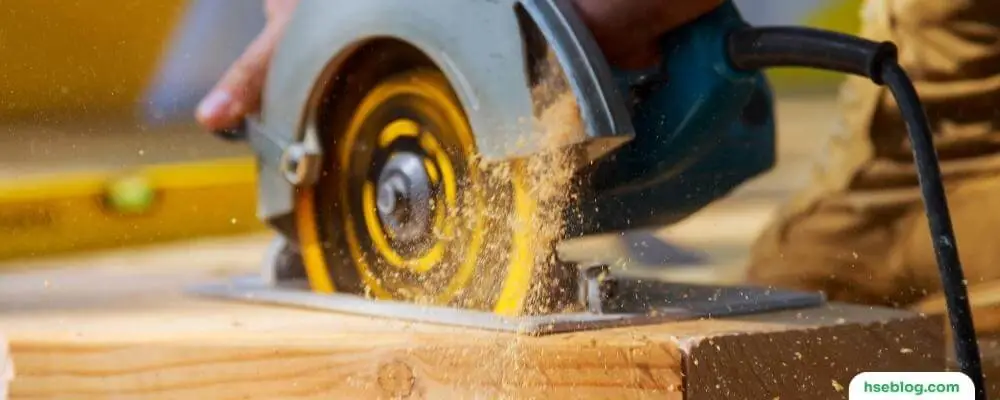
6. Fire Hazards
Power tools, especially those that involve cutting, grinding, or drilling, can generate sparks that ignite flammable materials or vapors, leading to fires. This is particularly a risk when working with or near materials like gasoline, solvents, dust, and even some types of wood.
Here are several precautions you can take to mitigate the risk of fire when using power tools:
- Clear work area: Keep your area free of flammable materials, including sawdust and other debris that could easily ignite.
- Proper storage and disposal of flammable materials: If you’re working with flammable materials or substances, ensure they’re stored in appropriate containers and disposed of properly.
- Ventilation: Good ventilation can help disperse flammable vapors, reducing their concentration in the air and minimizing the risk of ignition.
- Tool maintenance: Regularly maintain your power tools and keep them clean. Accumulated dust or grease on a power tool can be a fire hazard.
- Fire safety equipment: Keep fire safety equipment, such as fire extinguishers and fire blankets, close at hand and know how to use them.
- Safe refueling practices: If you’re using a tool that requires fuel, such as a gasoline-powered saw, ensure the tool is off and has cooled down before refueling. Fuel vapors can ignite from hot engine parts.
- Check for combustible materials behind work surfaces: When cutting or drilling into walls, floors, or other surfaces, check for hidden combustible materials. Sparks can ignite insulation, wiring, or other combustibles inside these structures.
- Use spark guards or deflectors: If your tool comes with a spark guard or deflector, always use it. This can help direct sparks away from you and any flammable materials.
- No Smoking: Avoid smoking in the area where power tools are being used, especially if flammable materials are present.
Understanding the potential fire hazards associated with power tools and taking appropriate safety measures can significantly reduce the risk of fires. Always remember that safety is paramount when working with power tools.
7. Eye Hazards
The risk to the eyes when operating power tools is significant. Various materials – from small wood or metal fragments to dust particles to sparks – can become airborne during tool operation and potentially cause eye injury.
Types of eye injuries can range from minor irritations, such as dust particles that cause itching or redness, to more serious injuries, such as cuts or punctures to the eye from flying debris. In severe cases, these injuries can result in permanent damage to vision.
Here are some preventive measures to protect your eyes when operating power tools:
- Safety glasses: Safety glasses are a basic level of protection that should always be worn when operating power tools. They are designed to protect your eyes from dust and debris. Look for safety glasses that meet the safety standards in your country (for example, the ANSI Z87.1 standard in the United States).
- Goggles: Goggles provide a higher level of protection than safety glasses by sealing around your eyes to keep out dust and debris, and they can be used over prescription glasses.
- Face shields: Face shields provide the most protection, covering your eyes and entire face. They are recommended for operations that produce a lot of debris or sparks or when using tools like grinders or chainsaws. However, face shields should be used with safety glasses or goggles, not as substitutes.
- Tool guards and dust extraction: Use tool guards and dust extraction systems if your tool has them. These can help to reduce the amount of debris that becomes airborne in the first place.
- Proper tool use and maintenance: Using the tool correctly and keeping it well-maintained can also reduce the amount of debris produced. For example, sharp blades produce less debris than dull ones.
- Keep your work area clean: Regularly cleaning your work area can help to reduce the amount of dust that can become airborne.
Remember, nothing is more important than your safety. Always ensure you are wearing the appropriate eye protection for the tool and task you are performing, and replace your eye protection if it becomes scratched or damaged, as this can impair vision and weaken the protection.
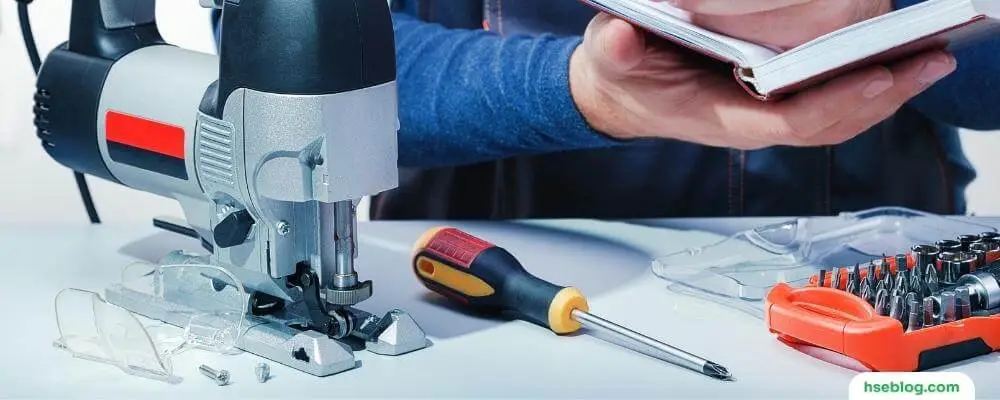
8. Repetitive Motion Hazards
Repetitive motion hazards are common but often overlooked risks associated with using power tools. These hazards can lead to repetitive strain injuries (RSIs) or musculoskeletal disorders (MSDs), which result from overuse or misuse of a particular muscle or group of muscles, usually due to repeating the same motions over an extended period. These injuries can affect various body parts, including the hands, wrists, elbows, neck, and back.
Examples of these disorders include carpal tunnel syndrome, tendinitis, and bursitis. Symptoms usually start gradually and can include discomfort, muscle fatigue, pain, swelling, decreased joint mobility, and in severe cases, loss of function.
To prevent repetitive motion hazards, consider the following precautions:
- Take regular breaks: Giving your muscles and joints a chance to rest is important. A short break every hour or so can help reduce the strain on your body.
- Rotate tasks: If possible, switch between different tasks throughout the day to avoid overworking one set of muscles.
- Use ergonomic tools: Ergonomic tools are designed to reduce strain and require less force. They fit comfortably in your hand and help keep your body more neutral and comfortable.
- Correct posture: Maintaining a good posture is essential. Avoid awkward positions and keep your body aligned when using power tools.
- Use the correct technique: Ensure you use each tool as intended and do not force it.
- Exercise and stretch: Regular exercise can help keep your muscles strong and flexible, reducing the risk of injury. Also, consider stretching before starting work and during breaks.
- Stay hydrated and maintain a healthy lifestyle: This may seem unrelated, but being healthy overall can help your body better resist and recover from strain and injuries.
Listening to your body and seeking professional help is crucial if you notice persistent discomfort or pain in using power tools. Early intervention is key to preventing long-term damage.
9. Battery Hazards
Battery-powered tools are increasingly common due to their convenience and portability. However, they can present hazards if not handled correctly, particularly if the batteries are damaged, mishandled, or improperly charged.
The two main types of batteries used in power tools are nickel-cadmium (NiCad) and lithium-ion (Li-ion) batteries. Both types can potentially cause injury, but Li-ion batteries, in particular, can risk overheating, fire, or even explosion if damaged or charged incorrectly.
Here are some precautions to consider to mitigate battery hazards:
- Use the correct battery: Always use the battery type and size specified by the tool’s manufacturer. Faulty or incompatible batteries can lead to poor tool performance and potential safety hazards.
- Inspect batteries: Before use, check batteries for any signs of damage, such as cracks, leaks, or bulges. Damaged batteries should not be used and must be disposed of properly.
- Handle batteries carefully: Do not damage or physically abuse batteries. Physical damage can lead to internal short circuits, causing the battery to overheat or burst.
- Proper charging: Only use the manufacturer’s charger, as different battery types require different charging methods. Overcharging or rapidly charging a battery can cause it to overheat, leading to potential fire or explosion.
- Avoid extreme temperatures: Both high and low temperatures can affect battery performance and safety. Avoid leaving batteries in hot or cold places, such as in a car on a hot day or in freezing conditions.
- Safe storage: Batteries should be stored in a cool, dry place when not in use. Removing batteries from the tool if it isn’t used for an extended period is also advisable.
- Dispose of batteries properly: Batteries should never be thrown in the regular trash. They contain hazardous materials and should be taken to a suitable recycling facility.
- Wear protective gear: Always wear appropriate when handling and changing batteries, including gloves and eye protection.
Following these precautions can significantly reduce the risks associated with battery-powered tools. Safety should always be your top priority when using any power tool.
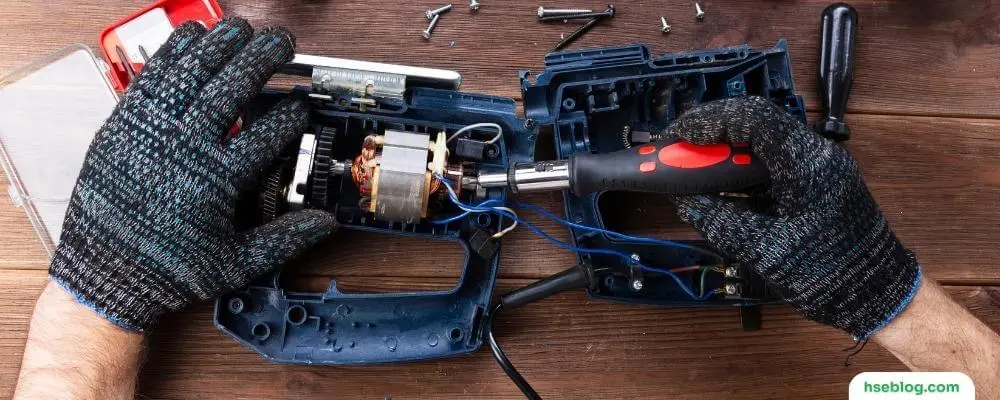
10. Lack of Machine Guarding
Machine guarding is an essential component of power tool safety. It protects users from hazards such as rotating parts, flying chips, sparks, and other unexpected movements that can cause injury. Despite its importance, not all portable power tools come equipped with sufficient guarding, which can elevate the risk of accidents.
Types of injuries that may result from lack of machine guarding include cuts, amputations, burns, eye injuries from flying debris, and entanglement, where loose clothing, hair, or jewelry gets caught in moving parts.
Here are some safety measures to consider:
- Use tools with proper guarding: Choose power tools equipped with proper machine guarding whenever possible. This includes guards around cutting blades, belts, gears, and other moving parts.
- Do not remove or alter guards: If your tool comes with a guard, do not remove or modify it. Guards are there for your protection.
- Check before use: Always ensure the guards are in place and functioning correctly before using the tool.
- Use push sticks or other safe devices: For tools like table saws, use push sticks or other safety devices to keep your hands away from the cutting area.
- Keep guards clean: Ensure guards are free from the buildup of dust or other materials that could affect their operation.
- Wear appropriate personal protective equipment (PPE): Depending on the tool and the job, this could include safety glasses or face shields, gloves, and sturdy, closed-toe shoes.
- Ensure loose clothing, hair, or jewelry is secured: These items can get caught in moving parts, so make sure they’re not a risk before you start working with the tool.
- Get training: Understanding how to use each tool safely, including how to use the guards correctly, is essential. If you’re unsure, seek advice or training before using the tool.
Remember that safety should always be the first priority when working with power tools. A moment’s inattention can lead to serious injury, so it’s worth ensuring you use your tools safely and correctly.
Conclusion
In conclusion, while highly useful and often essential, power tools carry a range of visible and unseen hazards that users must be aware of. These unseen dangers, including noise, vibration, dust, kickback, electric shocks, fire, eye injuries, repetitive motion hazards, battery-related risks, and lack of machine guarding, are just as critical to recognize and mitigate as the more apparent risks.
Understanding these hazards is the first step in improving safety when using power tools. We hope this blog post has shed light on these often-overlooked aspects of power tool use and has provided valuable insights on preventing these hazards.
Remember, the key to safe tool usage lies in awareness, proper training, and consistent use of protective measures. Always ensure you’re using the correct tool for the job, maintain your tools well, and don’t hesitate to invest in personal protective equipment. Regular breaks, rotating tasks, and being aware of your environment are also crucial.
Safety with power tools is not just about avoiding immediate injuries—it’s about safeguarding your long-term health. Remember these safety guidelines as you continue your work with power tools. Remember, no project is so urgent that we should overlook safety. Take the time to protect yourself and promote a safer workspace.

